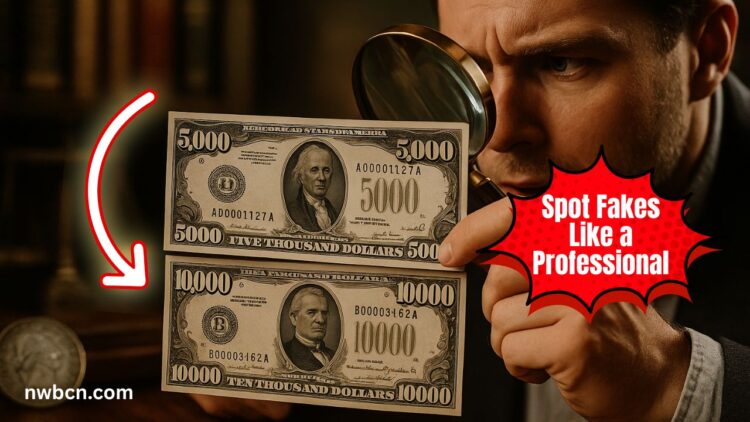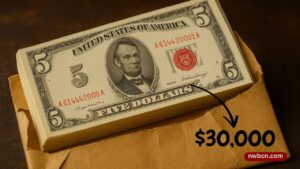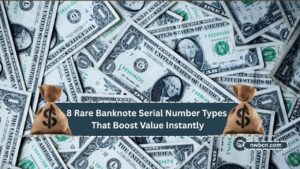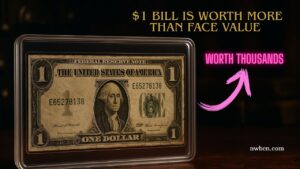The 1934 Series $5,000 and $10,000 Federal Reserve Notes, featuring portraits of James Madison (F5,000) and Salmon P. Chase (F10,000), were among the largest denominations ever issued by the U.S. Treasury.
Though primarily used between Federal Reserve branches, they were never widely circulated. Today, they are coveted collectibles—but also targets for counterfeiters.
With genuine examples commanding six to seven-figure values, detecting a fake is critical for collectors and dealers alike.
Know the Real Details: Design, Paper, & Security Features
Genuine Notes Have
- Portrait quality: Intricate intaglio engraving with sharp lines and rich depth—Madison on the $5,000, Chase on the $10,000.
- Raised printing: Pre-1990 currency like these includes raised intaglio ink noticeable to the touch.
- Special paper composition: Authentic bills use 75% cotton and 25% linen with embedded red and blue security fibers. Counterfeits often use wood-based or generic printing paper.
- Federal Reserve and serial numbering: Precise, even, and correctly formatted with district identifiers and script matching the series year.
Compare Fiber & Ink Quality
| Feature | Genuine Details | Common Fake Pitfalls |
|---|---|---|
| Paper feel | Sturdy, cloth-like, slightly textured | Thin, smooth, similar to regular printer paper |
| Security fibers | Embedded red/blue fibers visible across the note | Often missing or surface-printed |
| Ink clarity | Crisp edges in portraits, seals, and lettering | Blurry or pixelated from inkjet or offset |
| Raised printing feel | You can feel embossed ink on the portrait/seal | Flat print lacks actual texture |
Counterfeits often rely on inkjet or laser printing, yielding hazy details—this is a dead giveaway.
Evaluate Printing Methods & Under Magnification
- Intaglio vs. digital: Genuine intaglio printing leaves fine raised ridges and distinct shadows. Counterfeits struggle to replicate this tactile depth.
- Magnified inspection: Real bills show sharp, ripple-free lines in the treasury seal, portraits, and Washington building vignette. Fake seals often appear fuzzy or blotchy. ([turn0search1])
- Absence of watermarks or threads: Large-denomination notes of 1934 had no embedded thread or watermark, so their absence alone isn’t alarming—but added threads are red flags.
Serial Numbers & Series Date: Must Match Official Records
- Series year alignment: Genuine 1934 notes appear only with specific series variations (1934, 1934A, 1934B, sometimes 1934C/F). Others don’t exist and are immediately suspect.
- Serial number legitimacy: Look for district letter prefixes and matching seals (e.g., “F” for Atlanta, “C” for Philadelphia). Fake ones often use inconsistent formats.
- Plate & counter letter accuracy: Official notes include plate letters (e.g., “A” or “B”) and block letters that must match official Federal Reserve documentation.
Third-party Verification & Market History
- Over 240,000 small-size FRNs certified by PMG highlights the scarcity and value of high-denomination bills; few genuine $5k/$10k notes are known.
- PMG’s counterfeit warning: The 1934 “dollar” note showcased obvious signs—non-banknote paper and inkjet blur.
- Rule out reproductions: Recreated collectibles (including novelty gold strikes) are common. Key identifiers include “COPY” stamps and non-standard paper.
Quick Identification Chart
| Test | Genuine Appearance | Counterfeit Red Flag |
|---|---|---|
| Raised printing | Noticeable raised feel | Flat/inkjet, no texture |
| Paper quality & fibers | Cotton-linen blend with red/blue fibers | Smooth, pulp-based, no or poor fibers |
| Ink clarity | Sharp intaglio lines, crisp seal portraits | Fuzzy, pixelated, ink bleeding |
| Portrait detail | Fine engraving, clear facial lines | Smudged or blurred |
| Serial consistency | Format matches FR district codes | Mismatched, generic serials |
| Edge-to-edge design | Even margins, proper alignment | Cutoff edges or uneven |
| Certification | Graded by PMG/PCGS with tagging | Ungraded, suspicious holder or lack of slab |
Security Measures Introduced Over Time
Though 1934 bills lacked modern security, U.S. currency still had essential deterrents: frayed intaglio lines, fiber paper, and precise serial formatting.
For contemporary banknotes (post-1990), features like watermarks, threads, color-shifting ink, and microprinting further protect authenticity—but these do not apply to 1934 notes. ([turn0search6], [turn0search14])
Steps to Authenticate & Purchase Safely
- Visual & tactile inspection: Examine microscopic details, feel for raised elements.
- Use tools: Magnifier (10×) to assess ink clarity; cotton swab to inspect fibers; UV light to check paper fiber reactions.
- Compare reference images: Use official sources or verified graded notes.
- Check slab authenticity: For graded bills, verify slab serial numbers against PMG/PCGS database.
- Request provenance: Ask sellers for purchase receipts or collector history.
- Obtain grading before payment: If possible, grade the note first or ensure return policy.
What to Do If You Suspect a Fake
- Cease transaction immediately
- Contact local bank or dealer for opinions
- Report to Secret Service via their counterfeit-reporting portal. ([turn0search12])
- Don’t destroy the bill—handle minimally to preserve evidence
- Consider professional evaluation via PMG/PCGS, especially before private sale
The 1934 $5,000 and $10,000 Federal Reserve Notes represent both prestige and risk. With only a few authentic examples potentially in existence, they are prime targets for high-stakes forgery.
To confidently identify a genuine note, collectors must rely on raised printing, cotton-linen paper with embedded fibers, crisp intaglio details, and exact serial formatting.
When in doubt, always opt for professional grading and verification. This diligence protects both your investment and the integrity of American numismatic heritage.
FAQs
Q1: Can modern security pens detect fakes?
No. These pens test for wood-starch paper; 1934 bills are cotton-linen and won’t trigger a reaction, resulting in false negatives. ([turn0search20], [turn0search2])
Q2: Why aren’t there more genuine $10,000 or $5,000 bills?
These were used mainly by Federal Reserve Banks for large interbank transfers. Few were printed and even fewer escaped official holdings.
Q3: What if my bill matches pictures but isn’t certified?
Even if it looks correct, counterfeit technology is sophisticated. Always seek professional grading slab from PMG/PCGS before finalizing a purchase.




